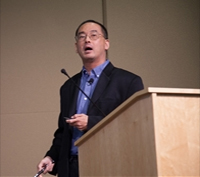
For the very first time, CDNLive Silicon Valley ran an academic track during its 2016 meeting, with a UC San Diego professor taking top honors. CDNLive is the Cadence User Conference, which attracts experts as well as users and developers of Cadence technologies and techniques for designing advanced silicon, systems, and systems-on-chip. The April 5-6 event took place in Santa Clara, CA, and drew a standing-room-only audience. According to a conference rapporteur, CSE and ECE Prof. Andrew Kahng "stole the show" with his talk on bridging the gap between academic research and commercial Electronic Design Automation (EDA)." To noone's surprise, the presentation, "Toward New Synergies Between Academic Research and Commercial EDA", received the Best Paper award for the Academic track, which included presentations by faculty from six other universities: USC, Arizona State, Georgia Tech, Purdue, Texas A&M, and the University of Calgary.
 On the day after he spoke at CDNLive, Kahng (at right) presented as part of Cadence's internal Distinguished Speakers Series. His talk focused on "PPAC Scaling at 7nm and Below." PPAC stands for power-performance-area-cost. The industry has talked about PPA for a long time, with the A for area also being a surrogate for cost. But with different process choices, multiple patterning vs. EUV someday and other options, area alone is not the only parameter that feeds into cost. According to a review of Kahng's talk by Cadence's Paul McLellan, the UC San Diego professor sees two megatrends that are driving "all the issues" in this area. The first is the "race to the end of the roadmap", i.e., taking Moore's Law as far as possible on existing or foreseeable knowledge, which is expected to result in volume production of 7nm technology in 2018. The second megatrend involves keeping power under control by adopting more extreme approaches after having "done a lot of the easy stuff in previous process generations" to enable low power for markets ranging from mobile to big data to cloud. Kahng's final call to arms in his Cadence talk was for a massive "moonshot" to predict tool outcomes, find the sweet spot for different tools and flows, and thus design in specific tool and flow knobs to the overall methodology. The end-result: a fully predictive, one-pass flow with optimal tool usage. With modern massively parallel, big-data architectures, argued Kahng, who is a former member of the Cadence Technology Advisory Board, it is not unreasonable to use tens of thousands of machines if it could "get us to the moon" of a non-iterative flow.
On the day after he spoke at CDNLive, Kahng (at right) presented as part of Cadence's internal Distinguished Speakers Series. His talk focused on "PPAC Scaling at 7nm and Below." PPAC stands for power-performance-area-cost. The industry has talked about PPA for a long time, with the A for area also being a surrogate for cost. But with different process choices, multiple patterning vs. EUV someday and other options, area alone is not the only parameter that feeds into cost. According to a review of Kahng's talk by Cadence's Paul McLellan, the UC San Diego professor sees two megatrends that are driving "all the issues" in this area. The first is the "race to the end of the roadmap", i.e., taking Moore's Law as far as possible on existing or foreseeable knowledge, which is expected to result in volume production of 7nm technology in 2018. The second megatrend involves keeping power under control by adopting more extreme approaches after having "done a lot of the easy stuff in previous process generations" to enable low power for markets ranging from mobile to big data to cloud. Kahng's final call to arms in his Cadence talk was for a massive "moonshot" to predict tool outcomes, find the sweet spot for different tools and flows, and thus design in specific tool and flow knobs to the overall methodology. The end-result: a fully predictive, one-pass flow with optimal tool usage. With modern massively parallel, big-data architectures, argued Kahng, who is a former member of the Cadence Technology Advisory Board, it is not unreasonable to use tens of thousands of machines if it could "get us to the moon" of a non-iterative flow.
Read a complete review by Cadence's Paul McLellan of Andrew Kahng's presentation to the Cadence Distinguished Speaker Series.
CDNLive Silicon Valley awards for Academic and other conference tracks.

